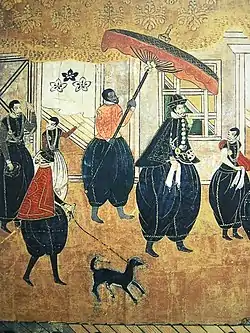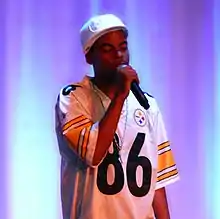| Regions with significant populations | |
|---|---|
| Tokyo, Okinawa | |
| Languages | |
| Japanese, English, African languages | |
| Related ethnic groups | |
| Black people |
Black people in Japan (黒人系日本人, Kokujinkei nihonjin /Nipponjin) are Japanese residents or citizens of sub-Saharan African ancestry.
History

In the mid-16th century, Africans arrived in Japan alongside Europeans as crew members and slaves.[1]
Yasuke, an African man, possibly from Mozambique, arrived in Japan in the late-16th century alongside Jesuit missionary Alessandro Valignano. He found favor with Oda Nobunaga, the daimyō and warlord, and ultimately became his retainer.[2]
After World War 2, with the Japanese economic miracle, many students from Africa began coming to Japan often to pursue relevant postgraduate education through MEXT and JICA.[3] African Americans also joined the JET Programme to work as English teachers. Some African Americans arrive to serve in the United States Forces Japan.
In 2015, Ariana Miyamoto, who was born in Japan to a Japanese mother and an African-American father, became the first hāfu (a term denoting mixed ancestry) contestant to win the title of Miss Universe Japan.[4] The decision to allow Miyamoto to win the title, as she is not full Japanese by descent, was controversial.[5]
Individuals
Japan-born
- Hisashi Appiah Tawiah, (born 1998), footballer of Ghanaian descent
- Ibrahim Junior Kuribara, (born 2001), footballer of Ghanaian descent
- Thelma Aoyama (born 1987), R&B singer of Afro-Trinidadian descent
- Kashif Bangnagande (born 2001), footballer of Ghanaian descent
- Abdul Hakim Sani Brown (born 1999), sprinter of Ghanaian descent
- Rui Hachimura (born 1998), basketball player of Beninese descent
- Dan Howbert (born 1987), footballer of Liberian descent
- Crystal Kay (born 1986), pop singer of African American descent
- Issey Maholo (born 1985), football goalkeeper of Congolese descent
- Ariana Miyamoto (born 1994), beauty contestant of African American descent
- Henry Armstrong Miller (born 1969), 1st sumo wrestler of African American descent(Sentoryū Henri)
- Mana Nakao (born 1986), footballer of Tanzanian descent
- Talla Ndao (born 1999), footballer of Senegalese descent
- Karen Nun-Ira (born 1991), judoka of Ghanaian descent
- Naomi Osaka (born 1997), tennis player of Haitian descent
- Ado Onaiwu (born 1995), footballer of Nigerian descent
- Evelyn Mawuli (born 1995), basketball player of Ghanaian descent
- Stephanie Mawuli (born 1998), basketball player of Ghanaian descent
- Powell Obinna Obi (born 1997), footballer of Nigerian descent
- Randy Emeka Obi (born 1999), footballer of Nigerian descent
- Richard T. Jones (born 1972), actor of American descent
- Leo Kokubo (born 2001), footballer of Nigerian descent
- Keita Buwanika (born 2002), footballer of Ugandan descent
- Anrie Chase (born 2004), footballer of Jamaican descent
- Jefferson Tabinas (born 1998), Japanese footballer of Ghanaian descent
- Paul Tabinas (born 2002), footballer of Ghanaian descent
- Solomon Sakuragawa (born 2001), footballer of Nigerian descent
- Joel Chima Fujita (born 2002), footballer of Nigerian descent
- Zachary Herivaux (born 1996), footballer of Haitian descent
- Dave Roberts (born 1972), baseball player of American descent
- Aja Kong (born 1970), professional wrestler of African American descent
- Jim Bowie, (born 1965), baseball player of African-American descent
- Osamu Henry Iyoha, (born 1998), footballer of Nigerian descent
Foreign-born

- Asuka Cambridge (born 1993), Jamaica-born sprinter
- Pape Mour Faye (born 1986), Senegal-born basketballer
- Samba Faye (born 1987), Senegal-born basketballer
- Chris Hart (born 1984), US-born pop singer
- Jero (born 1981), or Jero, US-born enka singer
- Kotaro Matsushima (born 1993), South Africa-born rugby union player
- Kaoru Mfaume (born 1976), US-born entertainment producer
- Ike Nwala (born 1986), US-born TV presenter and comedian
- Andy Ologun (born 1983), Nigeria-born professional boxer, mixed martial artist, kickboxer, and actor
- Bobby Ologun (born 1968), Nigeria-born television personality
- Alessandro Santos (born 1977), Brazil-born footballer
- Mandy Sekiguchi (born 1991), US-born rapper
- Jelani Reshaun Sumiyoshi (born 1997), US-born footballer
- Musashi Suzuki (born 1994), Jamaica-born footballer
- Zion Suzuki (born 2002), US-born footballer
- Umi (born 1999), US-born singer and songwriter
- Yasuke, Africa-born retainer of Oda Nobunaga
References
- ↑ Leupp, Gary P. (1995). Images of Black People in Mediaeval and Early Modern Japan, 1543–1900.
- ↑ Mohamud, Naima (14 October 2019). "Yasuke: The mysterious African samurai". BBC News. Retrieved 21 May 2021.
- ↑ studyinjapan-africa.com
- ↑ Fackler, Martin (29 May 2015). "Biracial Beauty Queen Challenges Japan's Self-Image". The New York Times. ISSN 0362-4331. Retrieved 13 February 2019.
- ↑ Olya, Gabrielle (23 March 2015). "Miss Universe Japan Ariana Miyamoto Criticized for Not Being Japanese Enough". People. Retrieved 12 May 2015.
